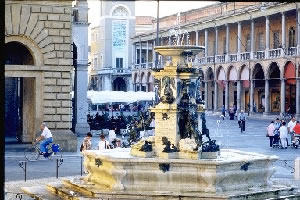Address: Piazza del Popolo, 31
Telephone: 0546/691111
E-mail: urp.informazioni@comune.faenza.ra.it
Website: www.comune.faenza.ra.it
Faenza, along the via Emilia, is an ancient Roman city. Only a few architectural examples remain of the medieval period, for example: St. Hippolytus and the churches of St. Maria Foris Portam and the Commenda. The same cannot be said for what was one of the brightest periods of Faenza during the dominion of the Manfredi family.
In fact, a thriving era began with the rebuilding of the Cathedral in 1474, with the influence of Tuscan renaissance art. Artists such as Giuliano and Benedetto da Maiano, Donatello, the Della Robbia, Biagio d’Antonio of Florence and others moved to Faenza to work. The Baroque period instead boasts many great architectural works that represent the current face of Faenza: the structure of the two main piazzas with fountain, the clock tower, the loggias and the arcade wings of the Palazzo del Comune (Town Hall) and the Palazzo del Podestà.
Most of the church convents were then rebuilt in elegant late Baroque style, as were many aristocratic buildings. The blooming neo-classic age at the end of the XVIII century up to the first thirty years of the following century remains the same, with examples of artistic importance through the works of Giuseppe Pistocchi, Giovanni Antonio Antolini, Felice Giani, Gaetano Bertolani, Gianbattista and Francesco Ballanti Graziani, Antonio Trentanove and Pietro Tomba. Amongst the many works, Palazzo Milzetti majestically seals what was the Romagna civilisation of neo-classicism under both an architectural and decorative profile.
Faenza’s Ceramics
The ceramics of Faenza boasts a tradition of many centuries that also today continues to hold significant importance in artisan and industrial expression. The geographic location of the city makes it a meeting point between the Tuscan and Po cultures, becoming a ceramic centre of primary importance since the Middle Ages. The fame of these products of Faenza is such that the majolica is known throughout the world with the French name Faience.
Surface area (kmq): 215.72 sq. Km
Altitude: 34.80 m above sea level
Population: 53600 people
Density (Inhab. /kmq): 249
Directions:
It is possible to reach Faenza by car following the Via Emilia or the A14 motorway – Faenza exit. The Bologna – Ancona, Faenza – Florence and Faenza – Ravenna train lines pass through the city. A great number of bus services are available.
Additional notes:
Distances in kilometres from Faenza: Bologna (50 km.), Rimini (45 km.), Ravenna (35 km.), Florence (100 km.).



